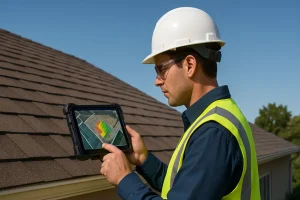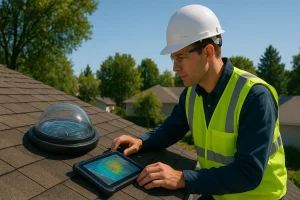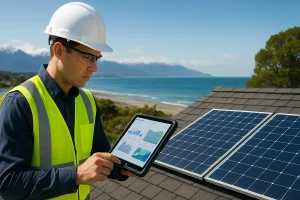Roof Solar Assessment Guide: Is Your Roof Right for Solar?

Roof Solar Assessment Guide: Ensuring Your Roof Is Ready for Solar
As the US solar industry continues expanding with over 10.8 GW of capacity added in Q1 2025 alone, solar installers and EPCs face increasing pressure to accurately assess roof suitability before committing to installations. Poor roof assessments can lead to system underperformance, costly reinstallations, and damaged customer relationships. The solution lies in implementing comprehensive roof solar assessment protocols that evaluate structural integrity, shading analysis, and material compatibility—ensuring every project maximizes energy production while maintaining long-term viability.
Understanding Solar Roof Assessment Fundamentals
A thorough roof solar assessment forms the foundation of every successful solar installation project. For solar installers and EPCs, this process determines project feasibility, system sizing, and ultimately, customer satisfaction. The assessment encompasses multiple technical evaluations that directly impact system performance and installation costs.

Modern roof assessment techniques have evolved significantly, incorporating advanced tools like satellite imagery analysis, structural load calculations, and comprehensive shading studies. These methodologies help solar professionals identify potential challenges early in the project development phase, reducing costly surprises during installation.
The financial implications of accurate roof assessments cannot be overstated. Studies indicate that proper site evaluation can improve system performance by up to 25% compared to installations without thorough preliminary analysis. This performance boost translates directly into higher customer satisfaction and stronger referral rates for solar contractors.
Key Components of Professional Roof Solar Assessment
Structural Integrity Evaluation
Structural assessment represents the most critical aspect of roof solar assessment. Solar panels add approximately 2-4 pounds per square foot to existing roof loads, requiring careful evaluation of the building’s capacity to handle this additional weight safely.
Professional assessments must examine roof framing, including rafter spacing, truss design, and deck condition. In regions with specific building codes—such as hurricane-prone areas in Florida or earthquake zones in California—these structural evaluations become even more crucial for compliance and safety.
Age plays a significant factor in structural assessment. Roofs approaching or exceeding 10-15 years may require replacement before solar installation, creating opportunities for solar installers to partner with roofing contractors for comprehensive solutions.
Comprehensive Shading Analysis
Shading analysis determines the solar potential of each roof section throughout the year. Even minimal shading can significantly impact system performance, making this evaluation essential for accurate energy production estimates.

Advanced shading analysis tools now utilize solar pathfinder technology and computer modeling to predict shadow patterns across different seasons. This data helps optimize panel placement and provides realistic production forecasts for customers.
Solar installers should document all potential shading sources, including neighboring buildings, trees, chimneys, and roof features. This documentation supports system design decisions and helps establish realistic customer expectations for energy production.
Roof Material and Condition Assessment
Different roofing materials present varying challenges and opportunities for solar installations. Asphalt shingles, metal roofing, tile, and flat membrane systems each require specific mounting approaches and considerations.
Material condition directly affects installation complexity and long-term system performance. Damaged, deteriorating, or poorly maintained roofing may necessitate repairs or replacement before solar installation can proceed safely.
Documentation of roof material, age, and condition helps solar contractors provide accurate project timelines and cost estimates. This information also supports warranty considerations and maintenance planning for long-term customer relationships.
Advanced Assessment Techniques for Solar Professionals
Technology Integration in Roof Assessment
Modern solar assessment leverages cutting-edge technology to improve accuracy and efficiency. Drone surveys, satellite imagery analysis, and 3D modeling software now enable remote preliminary assessments, reducing initial site visit requirements.
These technological tools provide detailed roof measurements, slope calculations, and orientation data essential for system design. Integration of these technologies into standard assessment protocols can significantly streamline the project development process for busy solar contractors.
Aurora Solar, HelioScope, and other specialized software platforms now offer comprehensive assessment capabilities, combining satellite data with advanced modeling to produce detailed feasibility reports and system designs.
Weather and Climate Considerations
Regional weather patterns significantly impact both roof assessment requirements and long-term system performance. Solar installers must consider local climate factors including wind loads, snow loads, and temperature extremes during assessment.

Historical weather data informs both structural requirements and energy production modeling. Understanding regional climate patterns helps solar professionals design systems that perform optimally throughout their 25-30 year lifespan.
Climate considerations also affect material selection and mounting system choices. Coastal installations require corrosion-resistant materials, while northern climates may necessitate enhanced structural support for snow loading.
Electrical Infrastructure Assessment
Electrical system evaluation forms a crucial component of comprehensive roof assessment. Panel capacity, service entrance location, and existing electrical condition all impact installation feasibility and costs.
Solar installers must assess whether electrical upgrades are necessary to accommodate the new solar system. These evaluations help provide complete project cost estimates and prevent costly discoveries during installation.
Coordination with electrical contractors during the assessment phase ensures all electrical requirements are identified and addressed in project planning, supporting smooth installation execution.
Streamlining Assessment Processes for Solar EPCs
Standardizing Assessment Protocols
Developing standardized assessment protocols ensures consistency across projects and installers. These protocols should include comprehensive checklists, documentation requirements, and quality control measures.
Standardized processes also support training programs for new technicians and help maintain service quality as solar companies scale their operations. Clear protocols reduce assessment time while improving accuracy and completeness.
Documentation standards should include photographic requirements, measurement protocols, and reporting formats that support both internal project management and customer communication needs.
Client Communication and Documentation
Effective communication of assessment findings builds customer confidence and supports informed decision-making. Clear, professional reports that explain technical findings in accessible language strengthen customer relationships.

Visual documentation, including photographs and diagrams, helps customers understand roof conditions and system design recommendations. This transparency builds trust and supports the sales process for solar installers.
Assessment reports should also include recommended next steps, timeline estimates, and cost implications to help customers plan their solar investment effectively.
Integration with Project Management Systems
Modern solar companies benefit from integrating assessment data directly into project management and CRM systems. This integration ensures assessment findings inform every subsequent project phase.
Digital assessment workflows support remote collaboration, quality control, and progress tracking throughout the project development process. These systems also enable data analysis to continuously improve assessment accuracy and efficiency.
Integration capabilities should support seamless handoffs between assessment teams, design engineers, and installation crews, maintaining project momentum and reducing communication gaps.
Conclusion: Partnering with Energyscape Renewables for Assessment Excellence
Accurate roof solar assessment represents the foundation of successful solar installations, directly impacting system performance, customer satisfaction, and long-term business success. As the solar industry continues evolving, solar installers and EPCs must embrace comprehensive assessment protocols that leverage advanced technology while maintaining focus on structural integrity, shading analysis, and material compatibility.
Energyscape Renewables understands the critical importance of thorough roof assessment in solar project success. Our comprehensive assessment services combine advanced technology with experienced engineering expertise to provide solar installers and EPCs with the detailed analysis needed for optimal system design and installation planning. Whether you’re evaluating residential rooftops or large commercial installations, our assessment protocols ensure every project starts with a solid foundation for long-term success.
For additional insights into cutting-edge solar technologies and industry best practices, explore the innovative solutions at Sunscape Solar, where advanced solar technologies meet practical installation expertise.

sjayakanth@energyscaperenewables.com